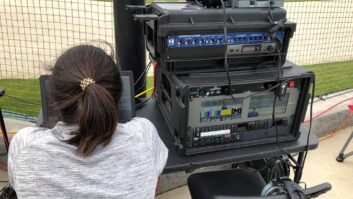IBOC Update – Feb 25, 2004
Feb 25, 2004 12:00 PM, compiled by Mark Krieger, CBT
Index:
- KRGN-FM and WNRK-FM Tap Harris for HDRadio
- NPR and FCC Finalizing Presentation Date forTomorrow Radio Report
- NAB Opposes Alert Devices Petition in Comments toFCC, Cites IBOC Concerns
- HD Radio Adoption Curve On the Upswing AmongBroadcasters, Receiver Manufacturers
- An Introduction to the New Language Surrounding HDRadio
- Broadcast Electronics to Unveil IBOC Offerings atNAB 2004
- Harris to Intro New IBOC Transmitters
- Car Audio Retailers Crutchfield, HookedOnTronics,Offer New Panasonic HD Radio Receiver
- The Digital Age Has Arrived
- The IBOC FM Waveform
To receive these articles twice a month in your e-mail, subscribe tothe IBOC Update – Insight on HD Radio e-newsletter. Click here to subscribe.
Business
KRGN-FM and WNRK-FM Tap Harrisfor HD Radio
Cincinnati – KRGN-FM, Amarillo, TX, and WNRK-FM, Norwalk, OH, haveselected Harris HD Radio transmission systems and other broadcastequipment for their implementation of HD Radio.
KRGN has purchased Harris’ Z4HDS FM digital and HT 25CD FM analogtransmitters for its separate amplification installation, as well as anFM antenna, transmission line, studio-to-transmitter link system andstudio equipment. WNRK, a repeater station for Kent State University’sradio station WKSU-FM, has purchased a Harris Z8HDC FM digitaltransmitter, a Dexstar FM digital exciter, and a Neustar codecprocessor. WNRK is one of four repeater stations for WKSU and will bethe first digital build-out in the network.
FCC Update
NPR and FCC FinalizingPresentation Date for Tomorrow Radio Report
NPR will present the contents of Hammett and Edison’s engineeringreport regarding the extensive testing of supplemental radio channelsvia HD Radio to the Federal Communications Commission sometime in”early March” according to NPR spokesperson Jenny Lawhorn. In atelephone interview with Radio magazine on Feb 23, Lawhorn saidthere were three dates currently under discussion and that anannouncement would be forthcoming.
Presentation of the report to the FCC is seen as a major step inobtaining the Commission’s approval for HD Radio hybrid FM stations totransmit multiple digital audio streams, referred to as supplementalaudio channels, or SACs. NPR and its nationwide group of non-commercialFM affiliates are extremely interested in this technology, since itwould allow a single affiliate to offer simultaneous music and talkprogramming. The Tomorrow Radio project included an extensive fieldtest of the technology by an industry consortium headed by NPR andpartially funded by the Corporation for Public Broadcasting.
A complete rundown of the study and report will appear in the Marchissue of Radio magazine.
NAB Opposes Alert Devices Petitionin Comments to FCC, Cites IBOC Concerns
The National Association of Broadcasters filed comments on Feb. 12asking the FCC to deny a petition for rulemaking previously filed byAlert Devices International Corporation. The Alert Device petitionseeks to amend the Commission’s rules to allow emergency vehiclewarnings to be transmitted over AM and FM broadcast radio signals,thereby creating an Emergency Vehicle Signaling Service (“EVSS”). Ifapproved, emergency vehicles would be permitted to broadcast low powersignals in both the AM and FM broadcast bands with the intent ofoverriding broadcast signals in order to alert motorists of theemergency vehicle�s presence.
Among the multiple objections to the proposal cited by the NAB was theobservation that no testing of the proposed system’s effect on IBOCdigital systems has been performed by the new systems proponents, andasserting, in part, that “the Commission must ensure that EVSS devices[do] not cause interference to any authorized service, including IBOC.The [Alert Devices] petition presents no evidence that would allow theCommission to make that judgment.”
The NAB filing also commented that “Alert Devices is already marketingand selling its transmitting device. NAB objects to Alert Devices’marketing and selling these devices without any FCC approvaland�strongly urges the Commission to immediately require AlertDevices to suspend all sales of these transmitting devices pending theoutcome of this proceeding� NAB objects to Alert Devices’marketing and selling these devices without any FCC approval and westrongly urge the Commission to immediately require Alert Devices tosuspend all sales of these transmitting devices pending the outcome ofthis proceeding.”
As of the date of this report, no reply to the numerous commentsreceived regarding the petition has been filed by Alert Devices, andthere is no indication of how the Commission will rule. Interestedparties can view all the documents at http://gullfoss2.fcc.gov/prod/ecfs/comsrch_v2.cgi. Besure to reference comments and replies in proceeding RM-10836.
Eye on IBOC
HD Radio Adoption Curve On theUpswing Among Broadcasters, Receiver Manufacturers
While the FCC hears a variety of proposals regarding how it willpermit implementation of IBOC digital broadcasting in the UnitedStates, HD Radio quietly continues to build momentum with broadcastersand consumer electronics manufacturers, two industries essential to itsembrace by the domestic entertainment market.
The number of broadcasters authorized to transmit an IBOC signal isgrowing monthly. A recent count indicates that more than 300 stationsare now on the air in more than 36 markets, making their digitalsignals available to an estimated 100 million consumers. Four of themajor HD Radio launch markets, New York, San Francisco, Seattle, andChicago, have a minimum of 10 stations operating in IBOC, while twomarkets, Los Angeles and Miami, have more than 18 stations each. By theend of 2004, it’s conservatively estimated that more than 600 stationswill be HD Radio equipped. Regulatory changes that could substantiallyreduce entry cost for FM stations and permit the sought-afterimplementation of secondary audio channels (permitting multicasting)could well triple that number in 2005.
Receiver manufacturers, a key part of the adoption equation, are alsocrossing the threshold. Panasonic and Alps, who are starting to shipproduct to the US, join Kenwood USA, the first company to actuallyrealize retail sales of an HD Radio tuner chassis just a month ago.Semiconductor leviathan Texas Instruments recently offered itsTMS320DR1250 single-chip solution for manufacturers seeking quick entryinto the market – and earned a coveted Product of the Year award fromElectronics Products magazine in January. Phillips semiconductorhas responded to TI’s challenge with its SAF3550 chip. In all, it’slikely that at least eight different consumer electronic brands will beactively marketing HD compatible products by year’s end.
The future of HD Radio and the fate of its developer, Ibiquity Digital,are still in question. But with an improving economy, and growingconsumer interest in America’s IBOC system, digital radio continues tomake steady progress.
HD RadioTerminology

AnIntroduction to the New Language Surrounding HD Radio
hybrid operation
: Refers to the operation of FM IBOC that combines a standard FManalog composite baseband modulation scheme operating in tandem withthe HD Radio digital signal modulation subcarriers. Hybrid operationallows for compatibility between broadcasters and new digital receiversas well as existing analog receivers.
all-digital operation: Refers to FM IBOC operation that does notinclude the traditional analog composite baseband signals. More robustand with more capacity than the hybrid system, this mode is currentlyenvisioned as a migration point for broadcasters as analog FMbroadcasting is eventually phased out.
Products
Broadcast Electronics to Unveil IBOCOfferings at NAB 2004
Quincy, IL – Broadcast Electronics will unveil new HD Radio productsduring NAB2004. Included in the lineup are new BE FSi10 and ASi10signal generators for digital FM and AM HD Radio, as well as acomplementary broadband microwave link and a data management system forboth HD and RBDS systems.
The FSi 10 HD Radio signal generator provides a low-voltage data stream(LVDS) signal to the new exciter. In tandem, the two units generate thedigital RF signal to be combined with analog FM for use in hybridsystems. The FSi 10 also provides delay matching of the analog and HDRadio audio paths, and encoding of the HD Radio Digital signal. Whenused with the FXi series digital FM exciter and its HD Radio plug inoption card, these two units provide an HD Radio plus FM output for usein low-level combined systems, or an HD Radio only signal for use inhigh-level combined implementations.
The ASi 10 HD Radio signal generator compliments BE�s line ofsolid-state AM transmitters, accepting an AES/EBU signal from theprogram source, and splitting it into digital and analog paths forconnection to discrete audio processing. The separately processedAES/EBU audio returns to the ASi 10 where the timing of the analog anddigital are synchronized and the digital signal encoded. The twosignals are then combined, providing phase and amplitude informationsent directly to the AM transmitter. A 400 x 600 VGA color display isprovided for control and monitoring and is standard on both the FSi 10and ASi 10 models.
Providing for the studio to transmitter link support for HD Radio’sability to carry multiple data streams, BE will introduce a newall-digital wireless 5GHz point-to-point broadband link capable of upto 45Mb/s. With configurable data allocation, the new broadband linkwill be able to carry a combination of digital audio, analog audio,AES/EBU uncompressed audio, Ethernet, RS-232 and HD Radio data.
To round off its new offerings, the company will also demonstrate adata applications management system designed to provide broadcastersintegrated control of both RBDS and HD ancillary text/datafunctionality, including automated tuner options.
Harris to Intro New IBOCTransmitters
Cincinnati – With a new line of 10W to 600W HD Radio transmitters,Harris can now support multiplexer input, interleaved antenna andseparate antenna applications. Like the Z-HD radio transmitters, theMini-HD line is available with the Neustar option, which can beconfigured to enable supplemental audio channels and 5.1 surround soundapplications. The new products will be unveiled at NAB2004.
Car Audio Retailers Crutchfield,HookedOnTronics, Offer New Panasonic HD Radio Receiver
Two major electronics retailers are now offering consumers a choicein HD Radio car receivers as a second offering appeared in the onlinecatalogs of Internet/mail-order giants Crutchfield andHookedOnTronics.com this month. Joining Kenwood’s KTC-HR100 tuner isPanasonic’s new MXE CQ-CB9900U single-DIN receiver, offering HD Radioalong with the ability to run CD audio and text along with MP3s.Detailed specifications and pricing information are viewable at bothretailers websites, though neither has committed to shipping beforeApril.
HD Radio proponents see the appearance of the Panasonic HD Radioproduct as significant, because it expands the field beyond the KenwoodIBOC tuner currently holding the distinction of being the only consumerproduct to be sold in the US as of February 2004.
Consumer automotive electronics manufacturers Alps, Delphi, Jensen,JVC, Sanyo and Visteon are all expected to ship HD Radio-compatibleproducts sometime during the coming year, but no firm dates or detailshave yet been made available.
More from Radiomagazine
The Digital Age Has Arrived
In Radio magazine’s February issue, editor Chriss Schererdiscusses the beginning of the digital radio age. Read it online at this link.
The IBOC FM Waveform
Also in the February issue of Radio magazine, John Battisoncovers the details of the IBOC waveform used for FM in the RFEngineering column. While stations may not deal with the fineintricacies of IBOC on a daily basis, understanding how the systemworks is essential to maintaining it.
Read the article online by following this link.












